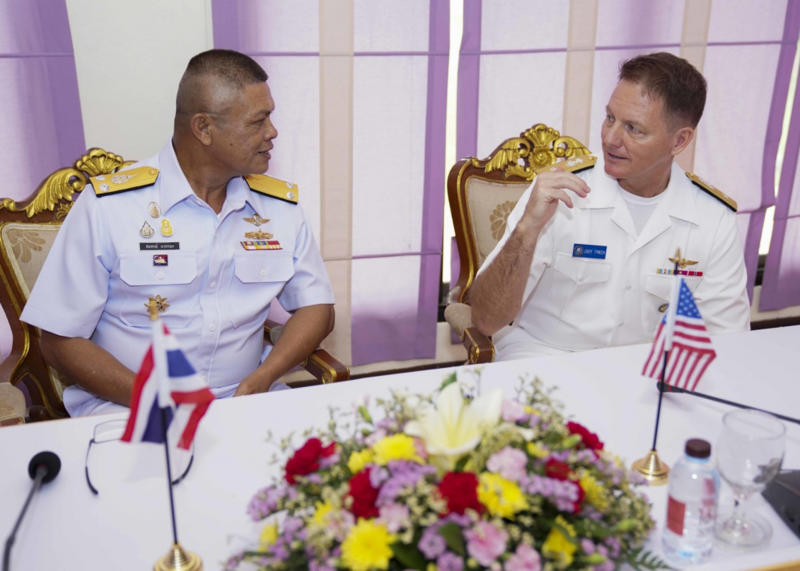Inaugural Asean-US maritime exercise a positive step towards a more networked region, says top US navy officer
Sign up now: Get ST's newsletters delivered to your inbox

US Navy Rear-Admiral Joey Tynch, commander of the Singapore-based Logistics Group Western Pacific, and Royal Thai Navy Rear-Admiral Sompong Narkthong, commander for the combined Asean-US task force during the Asean-US Maritime Exercise, following the exercise's opening ceremony at Sattahip Naval Base on Sept 2, 2019.
PHOTO: US NAVY
Follow topic:
SINGAPORE - The inaugural Asean-US Maritime Exercise, which began on Monday (Sept 2), is a positive step towards building a more networked region, a top United States naval officer overseeing security cooperation in South-east Asia has said.
The challenges faced by countries in the maritime domain are beyond what any single nation can handle, and that is where partners and allies are force multipliers for peace and inter-operability, said Rear Admiral Joey Tynch, commander of the Singapore-based Logistics Group Western Pacific.
"That's an unparalleled advantage that no competitor or rival can match. I fully believe we are stronger when we sail together," he said, adding that the exercise was not meant to be a symbolic event but one that would provide value for each of the participating countries.
He was speaking with reporters in a conference call from Thailand, where the five-day drill began.
The exercise - the first of its kind between Asean and the US Navy - is co-led by the US and Royal Thai navies, with eight warships, four aircraft, and more than a thousand sailors participating.
During the exercise, boarding teams from the various navies will conduct search and seizure operations at sea. The sea phase takes place in international waters in South-east Asia, including in the Gulf of Thailand and the South China Sea.
Asked whether such an exercise would be enough to help Asean states deter any aggressive moves by China, Rear-Adm Tynch said that its focus was to enhance the skills needed for maritime security.
During the conference call, Rear-Adm Tynch said the significance of the exercise was best understood when seen against the pattern of relationships that the US has with its partners in the region.
"Each year, we have hundreds, perhaps thousands of security cooperation events, and these range from small meetings and workshops, to subject matter expert exchanges on a variety of topics, to large-scale exercises and port visits."
"The US Navy, along with our partners, have long known the importance and value of working together," he said.
He cited some of the other cooperation events which included the 25th Cooperation Afloat Readiness and Training (Carat) bilateral exercise series this year and the 18th South-east Asia Cooperation and Training (Seacat) multilateral exercise in August that had the largest-ever number of participating countries at 19.
The US also conducts the Pacific Partnership mission, which is the largest annual humanitarian assistance and disaster relief mission in the Indo-Pacific. This year's mission that ended in May involved countries such as the Philippines, Malaysia, Timor-Leste, Vietnam, and Thailand.
Rear-Adm Tynch was coy when asked if the Asean-US Maritime Exercise would be held again in the future, and involving other countries.
He replied: "All our focus right now is on completing this one safely, professionally, learning as much as can, and once this exercise is complete, we'll take a look at what we have and make provisions looking forward."

